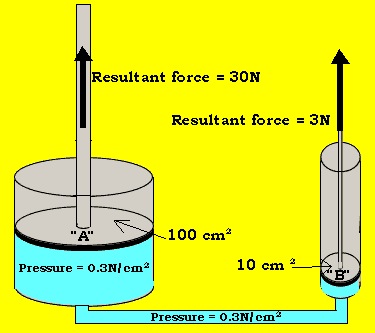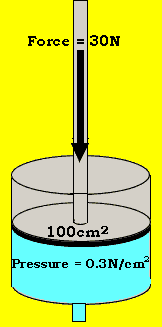| Hydraulics Force, Work and
Pressure. |
| The force
produced by a piston depends on the pressure the liquid inside the piston
is under and the surface area of the piston. The force can be calculated
according to the expression below. Force = pressure
X area Look at the single pistons
on the right. Piston "A" has a surface area of 100 cm2
and fluid at a pressure of 0.3N / cm2. The resultant force
is calculated as follows Force = 0.3N/cm2
X 100cm2 Force = 30N |
|
| |
Pressure is
the force exerted per unit area. Obviously the greater the force exerted
over a small area the greater the pressure. The piston on the left has a
surface are of 100 cm2and is pushed down with a force of
30 N. The pressure that the fluid inside the piston is under can be calculated
by the expression below
Pressure = force / area
Pressure = 30N / 100 = 0.3N/cm2 |
| |
Consider carrying 25 Kg of
bricks 25 metres along the road. You can say you have done some work.
Now try carrying 25Kg of bricks 50 metres along the road. You can now
say you have done more work than before. Work
is a concept defined by the expression below. Work
= force(N) X distance(m). So the work
done on the bricks to carry them 25 metres along the road is the product
of the force, exerted by the man to lift the bricks against gravtiy and
the distance travelled. The unit for
work is the joule. One joule
of work is done when a force of one Newton is applied over a distance
of one metre.
Consider the piston on the left. If a force of 3N is applied to lift
an object resting on the piston 3m high the work done on the object is Work = 3N X
3m = 9Nm = 9Joules. |
|


